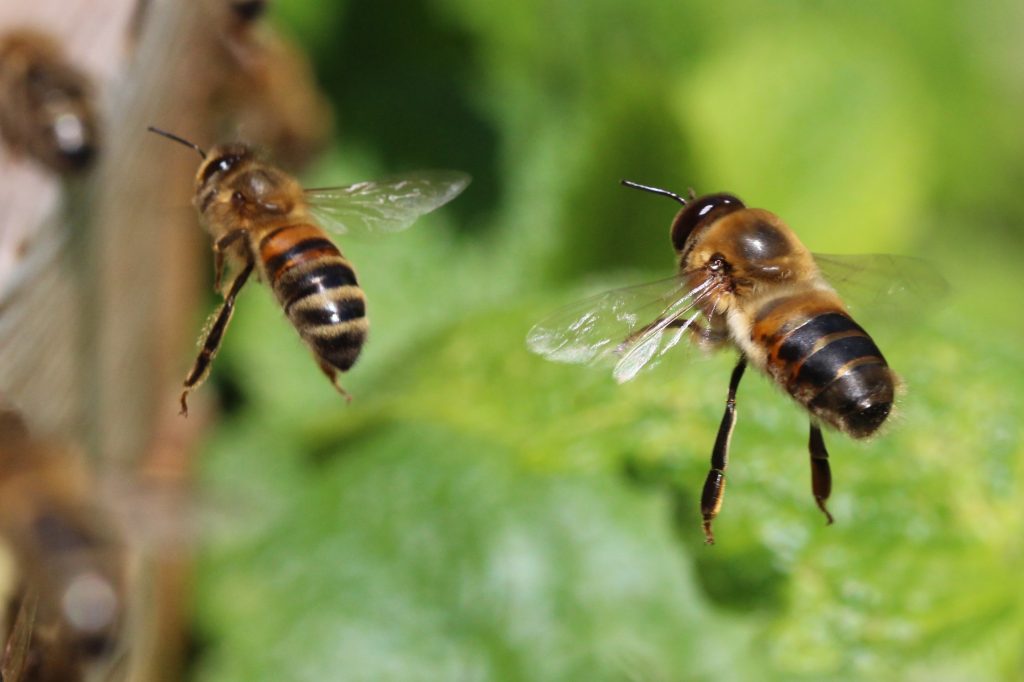
Drone Inheritance Recap.
We tackled the complicated story of drone genetics and inheritance last week, so let’s recap and move on to the development of a drone from an unfertilised egg. Female honey bees are diploid and have 2 sets of 16 chromosomes, but drones are haploid with only one set of 16 chromosomes. Because drones are haploid, drone gametes (sex cells) are reproduced by incomplete meiosis and all their gametes are identical.
Queens on the other hand use the elaborate genetic dance called meiosis to produce their gametes which are genetically diverse due to the shuffling of chromosomes and the recombination process. To maintain genetic diversity and colony strength, the queen mates with many drones. Polyandry is an adapted strategy evolved by honey bees to get around the potential problems associated with the species being haplo-diploid.
A drone is not genetically identical to his mother but he inherits a random sample of half her genes which include some of his grandfather’s. He has no father because the egg is not fertilised. His name in English is derived from Germanic tremo, from drunjus used in the Gothic era, and means noise. We all know that familiar loud vibrating sound of a drones flying in spring because it is so like a small machine cutting through the air.
When we hear and see the first drones of the season, we are reassured that all is well within the colony. Drones are produced and raised only when times are good and the colony feels strong and ready to reproduce. Drone production is linked to pollen availability and depends upon it.
However, if we see small undersized drones very early in the spring, or at other times, we should be aware that the colony might have a drone laying queen, or laying workers due to poor queen mating, or death of the queen in the latter situation.
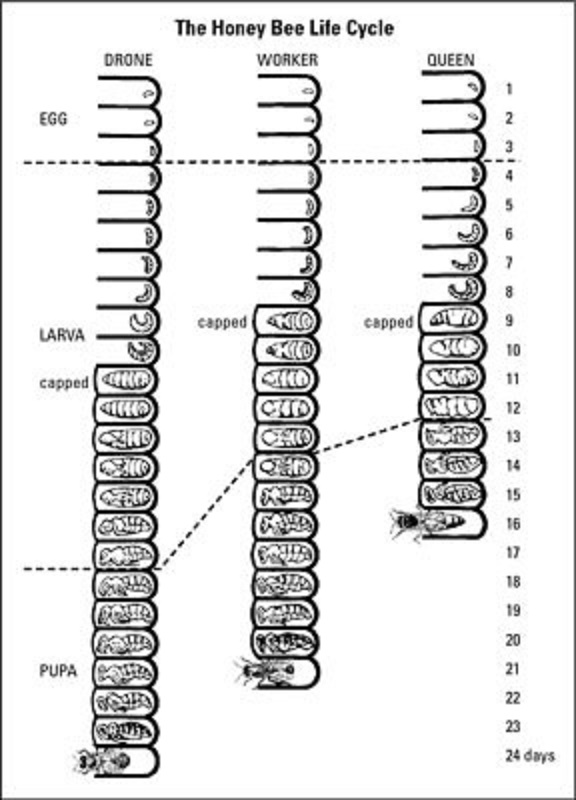
Drones are pretty special. They are very important and have complicated reproductive organs and a lot of energy and time go into their production. Compared with queens who emerge 16 days from when the egg was laid, workers emerge on day 21,and the drone pushes his way of his cell on day 24. Being larger, the drone requires to be fed greater amounts and more frequently prior to pupation, and on emergence he will weigh around 200 mg which is about twice as much as a worker. The number of drones in a population of honey bees will depend upon the size of the colony, time of year and forage availability. In the wild, a typical colony rears around 7,500 drones (1). A managed colony may contain between 2,000- 5,000 drones at any one time.
It’s interesting that natural selection favours an equal allocation of resources to the reproduction through males (drones) and females (swarms). In his book, The Lives of Bees, Seeley shows that the dry weights of dronesproduced by a colony (ca. 332g) is close to the dry weight of bees in swarms and afterswarms of a colony (ca. 391g). Although there are fewer drones than workers, because they are larger and more elaborately constructed, the energy and resources used to produce them is equal to those invested in total worker production.
In the wild, when a swarm settles in a new nest it builds comb from the top down, and in the first year builds hardly any drone comb and produces almost no drones during the first summer (3) because the effort of swarming has been tremendous and costly in energy. In the second year, drone comb is built on the bottom edges and along the sides. This is where we find drone cells in our managed colonies. When Tom Seeley (4) dissected the nests of colonies living in the wild, he found that they had , dedicated 17% of the comb area in their nests to drone comb. This is because drones are vital to the colony in terms of reproductive outcome. In managed colonies, less brood nest area is used for drone rearing, and, if we remove too much drone brood during varroa management the colony is “castrated” and may lose some of its insulating properties contributed by drones.
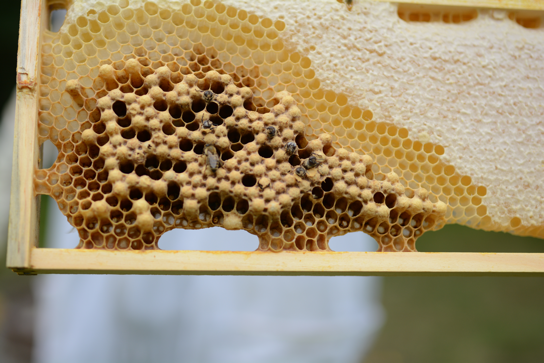
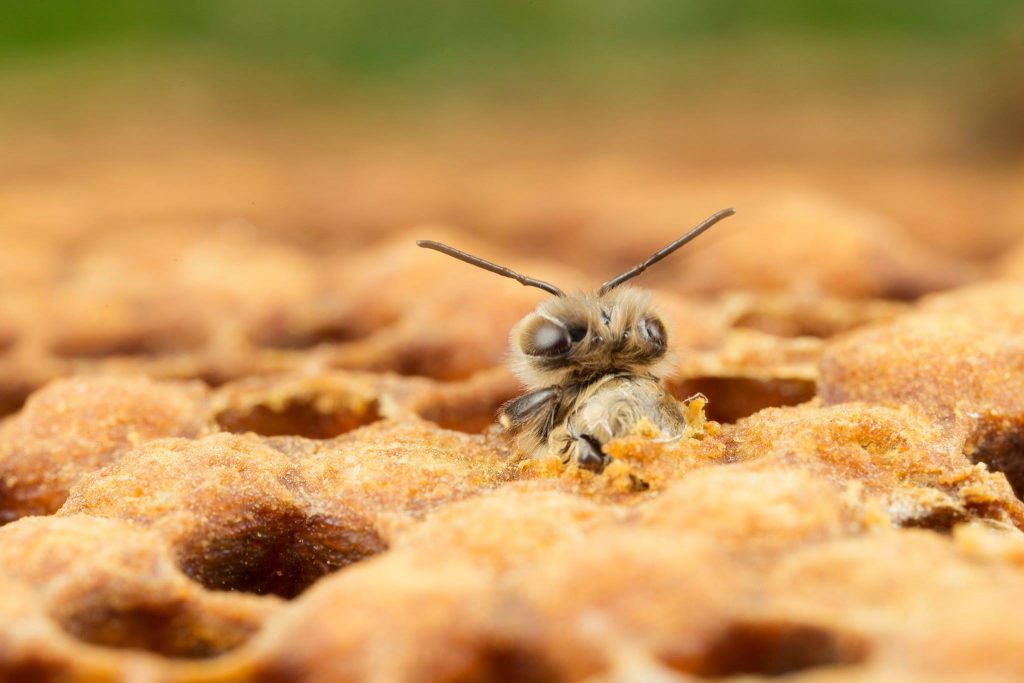
The drone emerges from his cell on day 24 compared with day 16 for queens, and day 21 for workers from egg. The drone is not yet mature enough for his main role which is mating with a queen. His reproductive organs are not yet fully developed, and it is not until around day 12 (post emergence) that he is capable of successfully mating. He stays in the brood nest area till around day 8 keeping warm and being fed by nurse bees from whom he begs food. He provides some insulation to the brood nest during this period.
Woodgate’s recent research (5) reveals new information about the mating behaviour of drones, and we learn that drones take orientation flights around day 8. They prepare for mating flights to the drone congregation areas by taking short 13- minute flights up to 100 m from the hive to orientate themselves and become familiar with landmarks around home.
Reproductive Development.
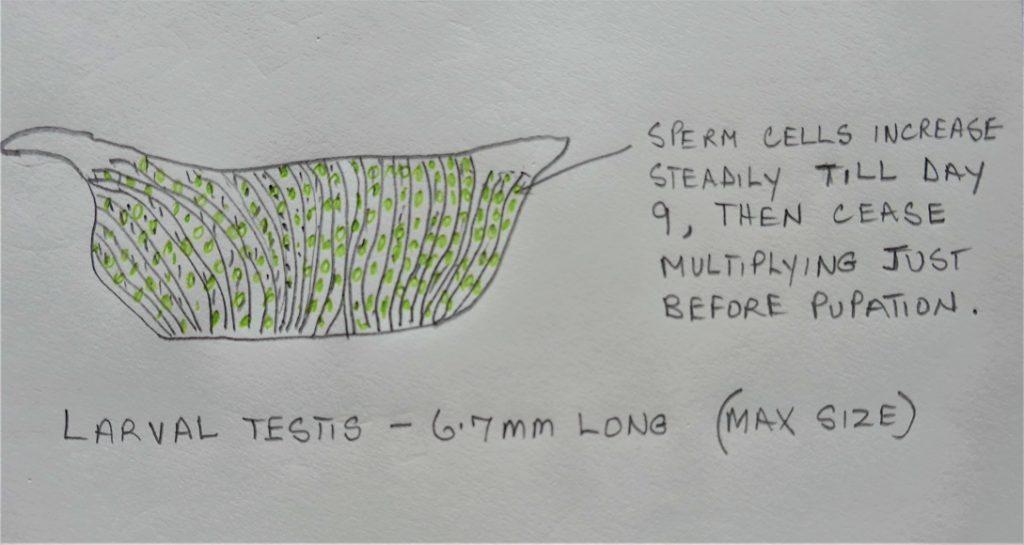
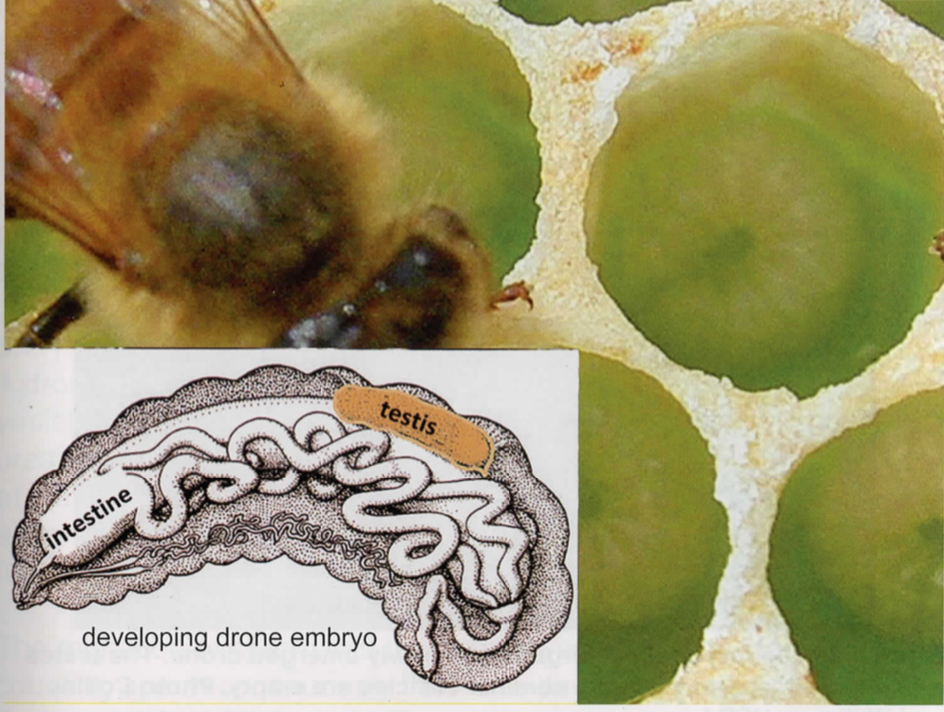
So, why does the drone take so long to mature? Well, he is larger than both queens and workers and that blunt, bullet-shaped abdomen is almost full of reproductive organs. Amazingly, it is during the larval stage that sperm cells multiply; they cease multiplying just before the pupal stage. The testes will will be as large as they will ever be then and are around 6.7 mm long. During pupation the mucus glands enlarge and the penis grows, but there are no other changes to the reproductive organs till emergence at day 24 when the final stage of sexual maturation begins.
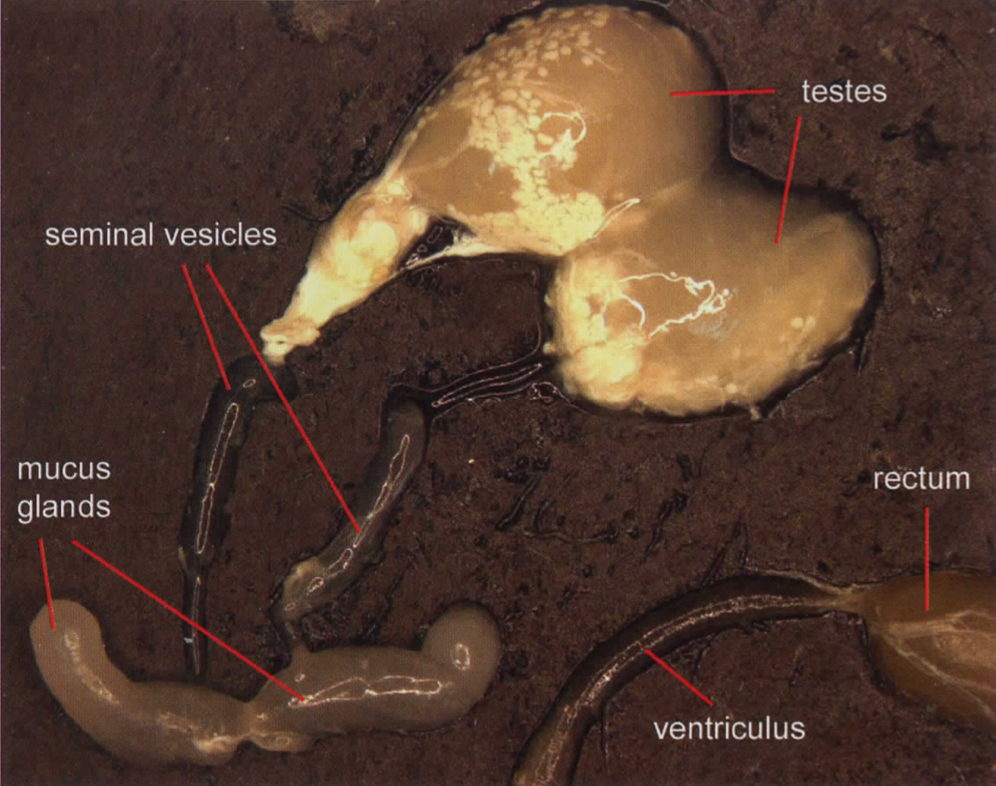
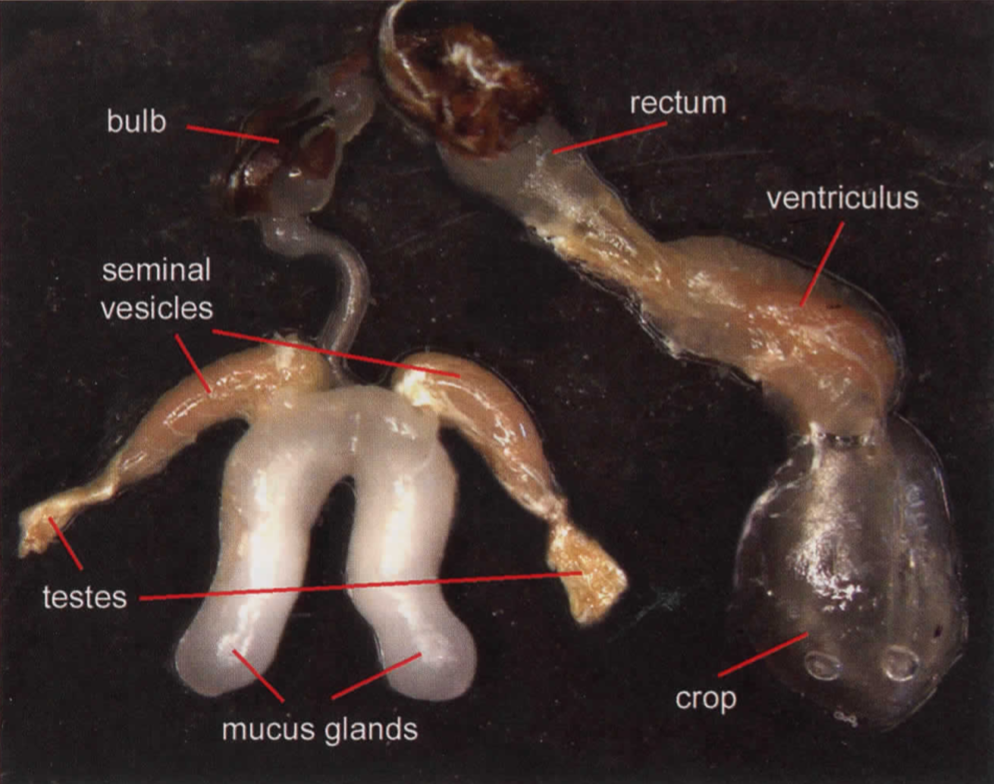
Around day 3 post-emergence, sperm start to migrate from the testes to the seminal vesicles. This continues over 10 days, so that by day 13 post emergence nearly all the sperm have migrated and the testes are now shrivelled and useless (6).
Unlike human males who have well developed and funtioning testes into old age, drones only have one shot at sex with no chance to reload so they don’t need active testes. Degeneration of these organs makes perfect sense when viewed under these economics.
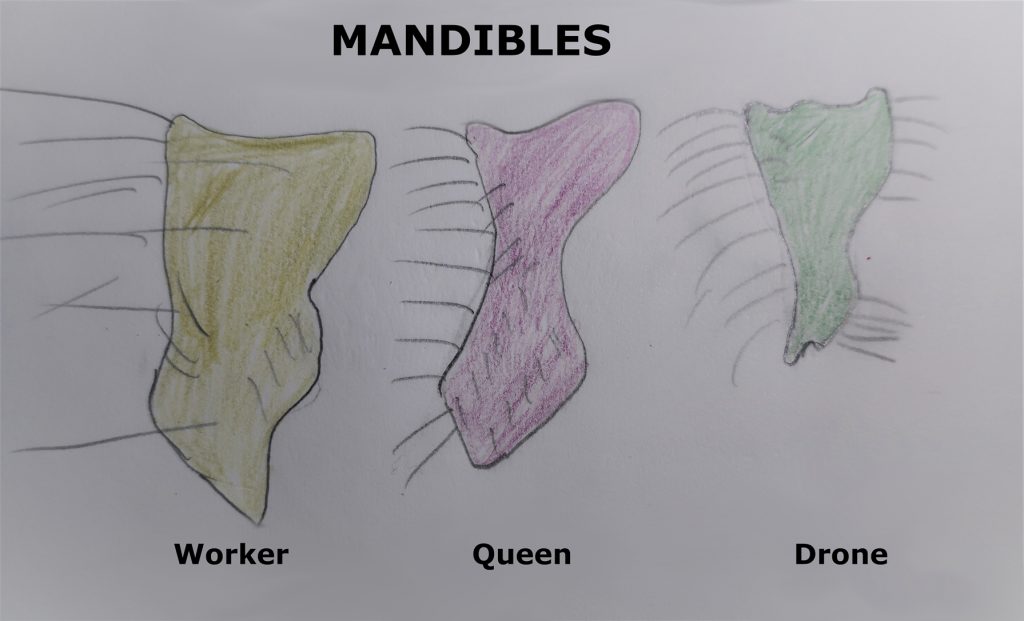
Before we talk about mating behaviour, I want to step back and consider the physical appearance and attributes of the drone compared with his female nest mates. Drones are constructed for mating and, unlike workers and queens, they don’t have body parts necessary for working around the nest. Their hind legs lack pollen baskets, and their mandibles/jaws are small because they do not chew propolis, manipulate wax, or use them in fighting as the queen does with her rivals. There are no mandibular grooves in a drone’s mandibles because, unlike workers, he doesn’t have hypopharyngeal glands to produce brood food. (These grooves guide hypopharyngeal glandular secretions to flow down into the mouth of the nurse bee engaged in feeding brood and queen.) The queen has no mandibular grooves either because her hypopharyngeal glands are very small and underdeveloped, and are otherwise called vestigial.
The drone’s proboscis is relatively short because he does not collect nectar, and mostly he is fed by worker bees although he will help himself to honey, sometimes.
Like the queen, the drone lacks wax glands. The other glands absent in the drone are: hypopharyngeal, as previously mentioned; Nasonov; alkaline (Dufour); and Koshevnikov glands.
The head salivary glands are vestigial and do not function whereas the thoracic salivary glands are small but functioning. The drone mandibular glands are small and thought to produce pheromones involved with orientation and finding drone congregation areas (7).
The drone has a smaller honey crop than a worker, and he lacks a sting.
When you examine a drone closely you will notice that he much hairier than the females, and this helps to preserve heat which is essential to keep his flight muscles operating. The drone’s flight muscles are larger than those of the females because he must fly faster than workers who can refuel in the field whereas he can only do this on return to the nest. If he cannot fly fast, he has no chance of catching up with a virgin queen, mating and passing on his genes. The drone’s wings are also broader than those of worker or queen.
The Bee’s Nose.
Karl von Frisch discovered that the antennae are the sensory organs associated with smell in honey bees. He removed the antennae of honey bees trained to visit dishes scented with essential oils, or natural flowers and noticed an impairment in the sense of smell of the bees without antennae.

The drone’s antennae are broader and longer than worker or queen antennae and have 12 segments compared with 11 segments in the latter. The segments include the pedicel and are counted down to the end segment. The antennae are involved with hearing, taste, touch, and smell, and are complex organs with at least 7 different types of sensory structures. There may be more yet to discover as our knowledge is still growing. The surface area of drone’s antennae is about twice as large as a worker’s. Oval shaped olfactory receptors called plate receptors covers it. These plate receptors are important in mating because they are very sensitive to the queen substance pheromone(9-oxo-2-decenoic acid) and they help the drone locate her. There are around 16,000 of these plate receptors in a drone’s antennae compared with around only 2,700 in the worker.
Hair- like receptors called trichoid sensillae are believed to be involved with taste. Unsurprisingly, workers have around 2,000 compared with only around 400 in a drone who have no foraging roles.
Both antennae are essential because a pair can compare the intensity of an odour and work out the direction that it coming from which is pretty amazing.
The pedicel houses the hearing apparatus and the organ of Johnston is located in this segment. Vibrations within the antennal flagellum are transmitted and picked by this cylinder-shaped organ which is involved with determining air speed. When the air passes over the antennae during flight, vibrations are created, depending on the speed of flight.
You can see how important drones are because of their role in passing on genes and ensuring genetic diversity. Colonies invest so much in their production and maintenance and yet they live for only a few weeks. Despite being so large and seemingly robust, drones are actually fragile and die easily when handled for activities such as simulated queen marking. Next week, I’ll be comparing drone and worker eyes and addressing mating behaviour.
References:
(1) & (2) Seeley, T.D, 2019. The Lives of Bees. Princeton University Press. Princeton and Oxford. P 172.
(3) Seeley, T.D, 2019. The Lives of Bees. Princeton University Press. Princeton and Oxford. P 132.
(4) Seeley, T.D, 2019, The Lives of Bees. Princeton University Press. Princeton and Oxford. P 133. (5)file:///C:/Users/ann/Documents/Research%20Articles/Woodgate’s%20drone%20tracking..pdf
(6) Koeniger G, Koeniger N, Ellis J, Connor C, (2014) Mating Biology of Honey Bees, Wicwas Press, Kalamazoo, Michigan. Page 45.
(7) Winston, M.L. 1987, The Biology of the Honey Bee. Harvard University Press, Cambridge, Massachusetts. Page 41.

Thanks for another fantastic article Ann! Fascinating stuff – you have clearly done a huge amount of research and have a real gift for compiling the pertinent information and communicating it. The Beelistener notification brightens up my email inbox each Friday morning – and I’m already looking forward to hearing the next chapter in the drone’s story!
Hello, Chris, and thank you for commenting so postively on the article. It means a lot coming from you with your own level of knowledge. Yes, I did put a lot of work into it because I’m preparing a presentation and it always help me to research the background thoroughly first.
Thank you, Ann for writing that interesting and lucid article. I thoroughly enjoyed reading it.
Good to know you liked it Margaret, and thank you for commenting.
This is just at a breathtaking level of detail Ann – thank you so much. It always annoys me when I hear ‘there just here for the sex’. There is so much more to a drone than meets the eye. Thank you.
Liz
Hello Liz. The same thing annoys me too which is partly why it is so detailed. The other reasons are because of preparing a PowerPoint Presentation on the drone, and helping people prepare for exams.
Great article augmented by fabulous photos, diagrams and drawings!
Plate 3 , page 21 of COLOSS BeeBook Volume II “Standard methods for Apis mellifera anatomy and dissection”, found here https://www.researchgate.net/publication/259146312_Standard_methods_for_Apis_mellifera_anatomy_and_dissection
Shows a different identification of the mandibles. Perhaps your labels for queen and worker are reversed?
Nice article you referenced, Marian, and thank you for the comments. I think that I am not a very good artist is the problem, but I shall review the article and drawing next week.